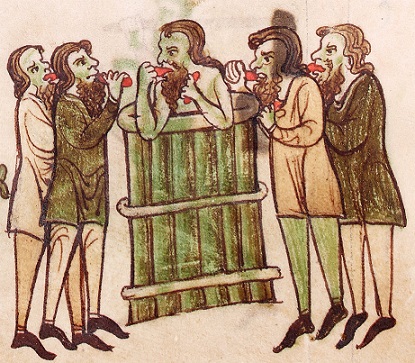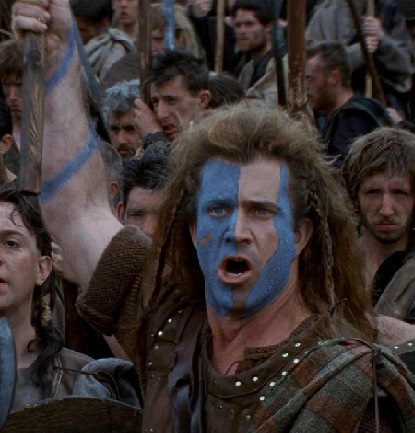
Kings At War

Introduction
In times of peace, knights enjoyed feasting and hunting, but their main job was to fight in the king's army.
During much of the Middle Ages, England was at war with its neighbours.
English people often portray the English kings of this time as heroic warriors.
To the Irish, Welsh, Scots and French, it must have seemed that they were nasty trouble-makers!
This map shows England and its neighbours in about the year 1300.
Study this webpage, then answer the question sheet by clicking on the 'Time to Work' icon at the top of the page.

Links:
The following websites will help you research further:
England and Ireland:
•
BBC KS3 Bitesize •
BBC website - by Simon Schama
•
TalkTalk encyclopaedia - quite difficult
England and Wales:
•
BBC KS3 Bitesize
•
Historic UK -
detailed narrative •
TimelinesTV
- video England and Scotland:
•
BBC KS3 Bitesize •
Education Scotland
England and France:
•
History Learning Site •
BBC website -
by Maurice Keen
•
TalkTalk encyclopaedia - quite difficult •
Video - useful
Ireland
Henry II invaded Ireland in 1171. Throughout the Middle Ages, the kings of England gave Irish land to English barons. They tried to force the Irish to speak English and to obey English laws and customs (such as having a bath). They failed.
This Irish lord has decided to take a bath, but he and his followers are eating raw horsemeat
The Irish lords rebelled again and again. English families who went to live in Ireland adopted Irish ways. By 1450 the English only ruled a small area round Dublin called the Pale.

Anti-Irish propaganda:
This Irish lord has decided to take a bath, but he and his followers are eating raw horsemeat!
Wales
Llewelyn ap Gruffudd, the ruler of Gwynedd, was the grandson of Llewelyn the Great – who had given King John so much trouble. Llewelyn started to cull himself the Prince of Wales.
In 1277, King Edward I invaded and conquered Gwynedd. He built a number of strong castles such as Beaumaris Castle.
Llewelyn was killed in 1282. He is known as 'Llewelyn the Last'.

English propaganda:
This painting from the 1930s glamorises a famous story from Welsh history.
Edward I promised the Welsh a prince of their own, who would be born in Wales and would not be able to speak English. In 1284, while Edward I was in Wales, his son Edward was born. According to legend, the king showed the baby to the people. 'Here is your prince,' he said. 'He was born in Wales and can speak no English.' Even today, the heir to the throne is called the Prince of Wales.
In reality, Edward was not declared Prince of Wales until 1301. He had spent little of his childhood in Wales.
Scotland
King Edward I also tried to conquer Scotland. In 1296, he invaded. The Scots resisted. They were led by William Wallace.
Wallace was captured and executed, but in 1306 another Scot, Robert Bruce, claimed the Scottish crown. He was defeated many times, but he kept on trying.
In 1307, Edward I died. On his grave were written the words: 'Edward, the Hammer of the Scots.' But his son Edward II was not as strong, and Bruce totally defeated him at the battle of Bannockburn (1314).
In 1320, the Scots published The Declaration of Arbroath. It said: "As long as 100 men remain alive, we shall never accept English rule. It is not for glory or riches that we are fighting, but for freedom."

Modern Anti-English propaganda:
The Hollywood film Braveheart (1995) tells the story of Wallace, but it is full of historical errors!
France
In 1337 King Edward III went to war with France. Fighting went on (with lulls in between) for more than a century. This is called the Hundred Years' War.
At that time, the English longbow was the most deadly weapon of the age. The English won great victories at the battles of Crecy (1346), Poitiers (1356) and Agincourt (1415). At times they controlled most of France.
But the kings of England did not have strong enough armies to keep control of France. In 1453, they were finally driven out, although they still owned the port of Calais.

Modern Hollywood Interpretations:
According to legend, a peasant girl called Joan of Arc inspired the French armies to drive out the English – though the invention of the cannon probably played a more important part in the French victory, because the French could capture the English castles
Joan of Arc was a real person, but it is very difficult to know what she was really like.
Left: Milla Jovovich (1999) played her as unstable and half-mad.
Right: LeeLee Sobieski (1999) portrayed her rather like a prefect in a posh girl's school!